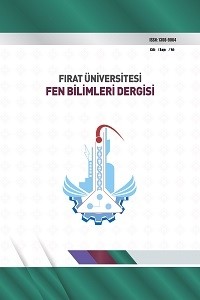Çay Tesisi Atıklarından Hidrotermal Yöntemle Aktif Karbon Üretimi
Çay tesis atıkları, fabrikada işlenen çaydan arta kalan organik atıklardır. Karadeniz Bölgesinde fabrikalarda yapılan çay üretimi sırasında her yıl on binlerce ton çay tesis atıkları oluşmaktadır. Bu çalışmada, Rize-ÇAYKUR tesislerinden temin edilen çay tesis atıkları kullanılarak hidrotermal yöntemle aktif karbon üretimi gerçekleştirilmiştir. Bu amaçla, numuneler hem aktifleştirici kullanılarak hem de aktifleştirici kullanılmadan hidrotermal cihazında (HTC) farklı süre ve sıcaklıklarda işleme tabi tutulmuştur. Elde edilen numunelerin SEM, EDX, BET ve metilen mavisi adsorbsiyon analizleri gerçekleştirilmiştir. Aktifleştirici ajan kullanmadan gerçekleştirilen deneylerden elde edilen numunelerin BET analiz sonuçlarına göre 100oC’de 8 saat işlem gören numunenin yüzey alanı 2,13 m2/gr olarak elde edilmiştir. Hidrotermal karbonizasyon sonrası aktifleştirilen numunelerin BET yüzey alanı ise KOH/Hidrochar oranına bağlı olarak 887.41 m2/gr ve 874.77 m2/gr olarak tespit edilmiştir. Ayrıca elde edilen ürünlerin 300 ppm’lik metilen mavisi adsorbsiyon deneylerinin Ultra-Viyole (UV) spektromtere ile ölçülen ekstraksiyon verimlerinin %99’a kadar ulaştığı hesaplanmıştır.
Anahtar Kelimeler:
Çay Tesis Atığı, Aktif Karbon, Hidrotermal Karbonizasyon.
Production of Activated Carbon from Tea Facilities Waste by Hydrothermal Method
Tea facility waste is the organic waste left over from the tea processed in the factory. Tens of thousands of tons of tea facility waste are consist every year during tea production in factories in the Black Sea Region. In this study, activated carbon has been carried produce by hydrothermal method using tea facility wastes provided from Rize-ÇAYKUR facilities. For this purpose, the samples were processed at different times and temperatures in a hydrothermal device (HTC) both activating agent using and without using an activating agent. SEM, EDX, BET and methylene blue absorption analysis of the obtained samples carried. According to the BET analysis results of the samples obtained from the experiments carried out without using an activating agent, the surface area of the sample processed at 100oC for 8 hours was obtained as 2,13 m2/gr. The BET surface area of the samples activated after hydrothermal carbonization has been detected as 887,41 m2/gr and 874,77 m2/gr, depending on the KOH/Hydrochar ratio. In addition, it was calculated that the extraction efficiencys of the obtained products measured by Ultra-Violet (UV) spectrofotometer in 300 ppm methylene blue absorption experiments reached up to 99%.
___
- Sharma, G., Naushad, M., Adsorptive removal of noxious cadmium ions from aqueous medium using activated carbon/zirconium oxide composite: Isotherm and kinetic modelling, J. Mol. Liq., 2020, 310, 113025. http://dx.doi.org/10.1016/j.molliq.2020.113025.
- Chingombe, P., Saha, B., Wakeman, R.J., Surface modification and characterisation of a coal-based activated carbon. Carbon NY., 2005, 43, 3132–3143. Http://Dx.Doi.Org/10.1016/J.Carbon.2005.06.021.
- Karnib, M., Kabbani, A., Holail, H., Olama, Z., Heavy metals removal using activated carbon, silica and silica activated carbon composite, Energy Procedia, 2014, 50, 113–120. http://dx.doi.org/10.1016/j.egypro.2014.06.014.
- Yaashikaa, PR, Senthil Kumar, P., Varjani, S.J., Saravanan, A., Advances in production and application of biochar from lignocellulosic feedstocks for remediation of environmental pollutants, Bioresour. Technol, 2019, 292, 122030. http://dx.doi.org/10.1016/j.biortech.2019.122030.
- Gerçel, Ö., Özcan, A., Özcan, A.S., Gerçel, H.F., Preparation of activated carbon from a renewable bio-plant of euphorbia rigida by H2SO4 activation and its adsorption behavior in aqueous solutions, Appl. Surf. Sci., 2007, 253, 4843–4852. Http://Dx.Doi.Org/10.1016/J.Apsusc.2006.10.053.
- . Tehrani-Bagha, AR, Balchi, T., Catalytic wet peroxide oxidation, adv. oxid process wastewater treat emerg. Green Chem. Technol, 2018, 375–402. http://dx.doi.org/10.1016/B978-0-12-810499-6.00012-7.
- Mohamad Nor, N., Lau, L.C., Lee, K.T., Mohamed, A.R., Synthesis of activated carbon from lignocellulosic biomass and its applications in air pollution control - A review, J. Environ. Chem. Eng., 2013, 1, 658–666, http://dx.doi.org/10.1016/j.jece.2013.09.017.
- Huang, Q., Gao, L., Sun, Y., Gao, Y., Li, B.Q., Wang, Y., Preparation, characterization and evaluation of adsorptive properties of leather waste based activated carbon via physical and chemical activation, Chemical Engineering Journal, 2013, 22, 62–71.
- Yaslı, MA, Antep fıstığı kavlatma tesisi atıklarından hidrotermal yöntemle aktif karbon üretimi, Mehmet Ali Yaslı, Yüksek Lisans Tezi, Fırat Üniversitesi, Fen Bilimleri Enstitüsü, 2019.
- Aslan, S., Çörek otu posasının aktif karbon üretiminde değerlendirilmesi, Fırat Üniversitesi Müh. Bil. Dergisi, 2021, 33(1), 193-201.
- González-García, P., Activated carbon from lignocellulosics precursors: a review of the synthesis methods, characterization techniques and applications, Renewable and Sustainable Energy Reviews, 2018, 82(1), 1393-1414.
- Suarez, L., Benavente-Ferraces, I., Plaza, C., de Pascual-Teresa, S., Suarez-Ruiz, I., Centeno, T.A., hydrothermal carbonization as a sustainable strategy for integral valorisation of apple waste, Bioresource Technology, 2020, 309, 123395.
- Çakmak, L., Şeker Pancarı Melası ve Küspesinden Hidrotermal Yöntemle Manyetik Nanopartikül Destekli Karbon (Mnpdk) Üretimi, Yüksek Lisans Tezi, Fırat Üniversite, Fen Bilimleri Enstitüsü, Elazığ, 2019.
- ISSN: 1308-9064
- Yayın Aralığı: Yılda 2 Sayı
- Başlangıç: 1987
- Yayıncı: Soner ÖZGEN
Sayıdaki Diğer Makaleler
Awo FOURREH ADAWEH, Betül TÜLEK
Onobrychis Bitkisine Ait Meyve Tiplerinin Makine Öğrenmesi Yaklaşımıyla Sınıflandırılması
Mehmet Selim KIZGIN, Zafer ÇAMBAY, Hakan SEPET, Salih Taha Alperen ÖZÇELİK, Hakan UYANIK
Çay Tesisi Atıklarından Hidrotermal Yöntemle Aktif Karbon Üretimi
Mustafa BOYRAZLI, Mustafa SÜNER, Emrah ÇELİK, Ayşegül DERE, Canan AKSU CANBAY, Erdoğan KARİP
Ali ŞAMİL, Tufan SALAN, Mehmet Hakkı ALMA
Tümleyenli Esnek ikili Parçalı Kesişim ve Birleşim İşlemleri Üzerine Daha Fazla Bilgi
